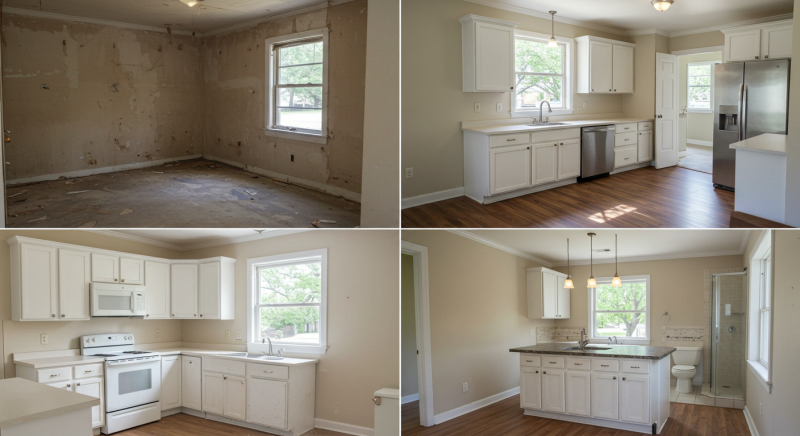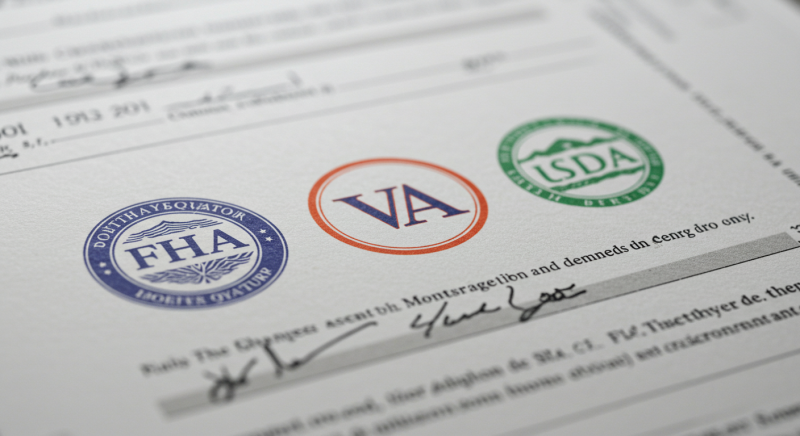Understanding Government-Backed Mortgage Options for American Homebuyers
The dream of homeownership remains a cornerstone of the American experience, yet for many, the path to securing a mortgage can seem daunting. Government-backed mortgage schemes in the USA offer powerful solutions for prospective homebuyers facing financial barriers. These programs provide crucial support that makes homeownership accessible to millions who might otherwise struggle to qualify for conventional financing.
Key Takeaways:
- Government-backed mortgage schemes offer lower down payment requirements and more flexible qualification criteria
- FHA, VA, and USDA loans provide specialized assistance for different buyer demographics
- Recent updates to government mortgage programs have expanded eligibility and improved terms
- First-time homebuyer initiatives include down payment assistance and tax benefits
- Understanding your eligibility for government-backed mortgage schemes can save thousands in homebuying costs

The Evolving Landscape of Government-Backed Mortgage Support
The history of government-backed mortgage schemes in the USA dates back to the Great Depression when the Federal Housing Administration (FHA) was established to stabilize the housing market. Since then, these programs have evolved to address changing economic conditions and homeownership barriers. Today’s government-backed mortgage schemes provide a lifeline for millions of Americans, particularly those with modest incomes, limited credit histories, or minimal savings for down payments.
Government-backed mortgage schemes fundamentally differ from conventional loans because they’re insured or guaranteed by federal agencies. This government backing reduces risk for lenders, allowing them to offer more favorable terms to borrowers who might not otherwise qualify. The result is a mortgage ecosystem that promotes broader homeownership across diverse economic backgrounds.
Types of Government-Backed Mortgage Programs
FHA Loans: Opening Doors for First-Time Buyers
FHA loans represent one of the most accessible government-backed mortgage schemes in the USA. These loans require down payments as low as 3.5% for borrowers with credit scores of 580 or higher. For those with credit scores between 500-579, a 10% down payment is typically required. The program’s flexibility makes it particularly valuable for first-time homebuyers and those rebuilding credit.
Recent changes to FHA loan limits have increased maximum borrowing amounts in response to rising home prices. In 2025, the FHA loan limit for single-family homes in most counties is $472,030, with higher limits in high-cost areas. Additionally, the Department of Housing and Urban Development (HUD) has streamlined the application process, making it easier to navigate this government-backed mortgage scheme.
VA Loans: Honoring Service with Homeownership Support
VA loans stand as a testament to America’s commitment to its military community. This government-backed mortgage scheme offers eligible veterans, active-duty service members, and qualifying spouses the opportunity to purchase homes with no down payment and no private mortgage insurance requirements. The program also features competitive interest rates and limited closing costs.
The VA loan program has undergone significant improvements in recent years. Funding fee adjustments have benefited many borrowers, and the removal of VA loan limits for borrowers with full entitlement has expanded purchasing power in high-value markets. These enhancements have strengthened this crucial government-backed mortgage scheme for those who’ve served our nation.
USDA Rural Development Loans: Revitalizing Communities Through Homeownership
The USDA Rural Development loan program represents a specialized government-backed mortgage scheme designed to stimulate economic development in rural and suburban communities. These loans offer 100% financing for eligible properties in designated areas, making homeownership possible with no down payment. Income limits apply, but they’re often more generous than many applicants expect.
Recent updates to the USDA’s property eligibility maps have expanded the geographic reach of this government-backed mortgage scheme. Additionally, streamlined refinance options now make it easier for existing USDA borrowers to take advantage of lower interest rates without extensive documentation requirements.
Special Initiatives Within Government-Backed Mortgage Programs
First-Time Homebuyer Advantages
Government-backed mortgage schemes offer particular benefits for first-time homebuyers. Beyond the core programs, initiatives like the First-Time Homebuyer Tax Credit provide financial relief through tax benefits. Many states also offer complementary programs that can be used alongside federal government-backed mortgage schemes, creating powerful combinations that significantly reduce upfront costs.
The HomeReady and Home Possible programs, backed by Fannie Mae and Freddie Mac respectively, represent additional government-sponsored mortgage options with features specifically designed for first-time buyers. These programs allow for down payments as low as 3% and offer flexible sources of funds for closing costs.
Down Payment Assistance Programs
A critical component of many government-backed mortgage schemes involves down payment assistance. These programs help bridge the gap between savings and required down payments, often through grants, forgivable loans, or deferred payment loans. The National Homebuyers Fund and state housing finance agencies administer many of these programs, which can be used in conjunction with FHA, VA, or conventional loans.
Recent expansions in down payment assistance funding have increased the impact of these programs. Some assistance initiatives now provide up to $25,000 for qualified buyers in targeted areas, making government-backed mortgage schemes even more accessible for those with limited savings.

Qualifying for Government-Backed Mortgage Programs
Income and Credit Considerations
While government-backed mortgage schemes offer more flexible qualifying criteria than conventional loans, understanding the specific requirements remains essential. FHA loans typically require a minimum credit score of 500-580, depending on down payment, while VA loans have no official minimum score (though lenders often set their own minimums). USDA loans generally require scores of 640 or higher.
Income requirements vary by program and location. FHA loans consider debt-to-income ratios, typically allowing up to 43% (though exceptions can reach 50% with compensating factors). VA loans evaluate “residual income” rather than debt ratios exclusively. USDA loans have specific income limits based on location and household size.
Property Requirements and Location Factors
Government-backed mortgage schemes include property standards designed to ensure homes are safe, sound, and sufficient value to secure the loan. FHA appraisals evaluate basic safety and structural integrity. VA appraisals include a Minimum Property Requirements (MPR) assessment. USDA loans require properties to be in eligible rural areas as defined by program maps.
Location significantly impacts several aspects of government-backed mortgage schemes. Loan limits vary by county, with higher limits in high-cost areas. Some programs, like USDA loans, have geographic eligibility restrictions. Additionally, certain areas qualify for special incentives under various government-backed mortgage schemes, such as Good Neighbor Next Door, which offers significant discounts for teachers, law enforcement, and other public servants purchasing in revitalization areas.
Navigating the Application Process
Documentation and Preparation
Applying for government-backed mortgage schemes requires thorough preparation and documentation. Standard requirements include proof of income (tax returns, W-2s, pay stubs), bank statements, employment verification, and identification documents. Program-specific requirements vary; VA loans require a Certificate of Eligibility, while USDA loans need rural property verification.
Digital innovations have streamlined the application process for many government-backed mortgage schemes. Online portals now allow for electronic submission of documents, status tracking, and faster processing. These improvements have significantly reduced the timeline from application to closing for many borrowers.
Working with Approved Lenders
Government-backed mortgage schemes operate through approved lenders rather than directly through government agencies. Finding lenders experienced with specific programs improves the application experience. Not all lenders offer all government loan programs, so researching options remains important.
Lender comparison should consider not just interest rates but also origination fees, processing times, and customer service reputation. Some lenders specialize in particular government-backed mortgage schemes and may offer enhanced guidance through the process.
Current Market Trends Affecting Government-Backed Mortgage schemes in the USA
Interest Rate Environment and Program Adjustments
Government-backed mortgage schemes typically offer competitive interest rates compared to conventional loans, especially for borrowers with moderate credit scores. Recent Federal Reserve policy changes have influenced rates across all mortgage products, including government-backed options.
Program-specific adjustments have also impacted the landscape of government-backed mortgage schemes. FHA mortgage insurance premium reductions have lowered monthly costs for borrowers. VA funding fee adjustments have benefited certain categories of veterans. These changes highlight the responsive nature of government-backed mortgage schemes to economic conditions.
Housing Market Conditions and Accessibility Challenges
The current housing market presents unique challenges for buyers using government-backed mortgage schemes. Limited inventory and competitive conditions can complicate purchases, particularly when sellers receive multiple offers. Some sellers may prefer conventional financing over certain government-backed mortgage schemes due to perceived processing delays or appraisal requirements.
However, recent initiatives have addressed some of these concerns. Streamlined appraisal processes for certain government-backed mortgage schemes have reduced delays. Additionally, education efforts have helped dispel misconceptions about government loan programs among real estate professionals and sellers.

Refinancing Options Within Government-Backed Programs
Streamline Refinance Opportunities
Government-backed mortgage schemes include specialized refinancing options that simplify the process for existing borrowers. FHA Streamline Refinance, VA Interest Rate Reduction Refinance Loan (IRRRL), and USDA Streamlined Assist Refinance all offer reduced documentation requirements and potentially lower costs.
These streamlined options within government-backed mortgage schemes often waive appraisal requirements and simplify income verification, making the refinancing process faster and less expensive. These programs have helped millions of homeowners reduce their interest rates and monthly payments without extensive paperwork.
Cash-Out and Rehabilitation Options
Beyond rate reductions, government-backed mortgage schemes offer cash-out refinancing options that allow homeowners to tap into equity while maintaining the benefits of government-backed loans. FHA 203(k) rehabilitation loans provide financing for both purchase and renovation of properties needing repairs, addressing the challenge of finding move-in-ready affordable housing.
These specialized versions of government-backed mortgage schemes serve important needs in the housing market, allowing homeowners to improve existing properties or address financial needs while preserving favorable loan terms.
Future Directions in Government Housing Support
Policy Proposals and Program Expansions
The landscape of government-backed mortgage schemes continues to evolve through policy initiatives aimed at expanding homeownership opportunities. Recent proposals include expanded first-time homebuyer tax credits, down payment assistance enhancements, and modifications to existing loan programs.
Industry organizations and housing advocates continue to suggest refinements to government-backed mortgage schemes, focusing on addressing racial homeownership gaps, supporting underserved communities, and adapting to changing housing market conditions. These discussions shape the future direction of federal housing support.
Technology Integration and Process Improvements
Technology increasingly transforms the implementation of government-backed mortgage schemes. Automated underwriting systems continue to evolve, potentially expanding access by considering alternative data for creditworthiness assessment. Digital closing processes are becoming more common, reducing paperwork and simplifying the final steps of the mortgage process.
These technological advancements promise to make government-backed mortgage schemes more accessible, efficient, and responsive to borrower needs in coming years. Agencies continue to invest in system modernization to improve the experience for both lenders and borrowers.
Conclusion: Leveraging Government-Backed Mortgage Schemes for Your Homeownership Journey
Government-backed mortgage schemes represent a powerful resource for aspiring homeowners across America. By understanding the specific programs available, their eligibility requirements, and how to navigate the application process, potential homebuyers can access meaningful assistance that makes homeownership more affordable and achievable.
The landscape of government-backed mortgage schemes continues to evolve, with ongoing adjustments that respond to economic conditions and housing market challenges. Staying informed about these changes helps buyers maximize the benefits available through these programs.
For many Americans, particularly those facing down payment challenges, credit limitations, or income constraints, government-backed mortgage schemes offer the most viable path to homeownership. By working with knowledgeable lenders and housing counselors, prospective buyers can determine which programs best match their circumstances and take confident steps toward achieving their homeownership goals.

Frequently Asked Questions About Government-Backed Mortgage Schemes
What is the minimum credit score needed for an FHA loan?
FHA loans require a minimum credit score of 580 for a 3.5% down payment. Borrowers with scores between 500-579 may qualify with a 10% down payment. These flexible credit requirements make FHA one of the most accessible government-backed mortgage schemes for credit-challenged buyers.
Can I qualify for a VA loan if I served in the National Guard?
Yes, National Guard members can qualify for VA loans after six years of service, or after 90 days of active-duty service during wartime, or 181 days during peacetime. This government-backed mortgage scheme honors various types of military service.
Are USDA loans only available for farms or rural properties?
No, USDA loans are available for residential properties in designated rural and many suburban areas. Many eligible areas are surprisingly close to metropolitan centers. This government-backed mortgage scheme focuses on geographic location rather than property type.
Can I use government-backed mortgage schemes if I’ve had a previous foreclosure?
Yes, though waiting periods apply. FHA loans typically require a three-year waiting period after foreclosure, while VA loans generally require a two-year waiting period. These government-backed mortgage schemes offer pathways back to homeownership after financial setbacks.
Do government-backed mortgage programs have income limits?
USDA loans have specific income limits based on location and household size. FHA and VA loans don’t have income limits, but they do consider debt-to-income ratios. Each government-backed mortgage scheme has its own approach to ensuring borrowers can afford their payments.
Can I avoid mortgage insurance with government loans?
VA loans don’t require mortgage insurance, though they do have a funding fee. FHA loans require mortgage insurance for the life of the loan in most cases. USDA loans have a guarantee fee and annual fee. The structure of each government-backed mortgage scheme determines these costs.
Are there property price limits for government-backed loans?
Yes, FHA and VA loans have county-specific loan limits that effectively create price ceilings unless buyers make larger down payments to cover the difference. These limits on government-backed mortgage schemes vary significantly based on local housing costs.
Can self-employed individuals qualify for government-backed mortgages?
Yes, self-employed borrowers can qualify for government-backed mortgage schemes, though they typically need to provide additional documentation, including 1-2 years of tax returns, to verify income stability and business performance.
Are there special government-backed mortgage options for teachers or public servants?
Yes, programs like Good Neighbor Next Door offer significant benefits for teachers, law enforcement officers, EMTs, and firefighters. Additionally, public service employees may benefit from other specialized government-backed mortgage schemes or complementary assistance programs.
How long does the approval process take for government-backed loans?
Processing times vary by loan type and lender efficiency. FHA loans typically take 30-45 days, similar to conventional loans. VA loans may take slightly longer due to the Certificate of Eligibility verification. USDA loans often take 30-60 days, with rural property verification adding potential time. Experienced lenders can often expedite government-backed mortgage schemes processing.
read more
external source
- U.S. Department of Housing and Urban Development (HUD)
- Federal Housing Administration
- U.S. Department of Veterans Affairs
- USDA Rural Development
- Consumer Financial Protection Bureau